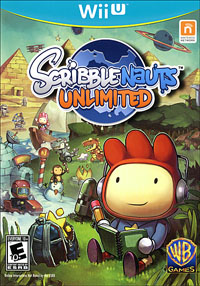Scribblenauts has been around for a while now with a few previous games designed specifically for handheld systems, but it took the Wii U and the release of Scribblenauts Unlimited before I sat down to take a serious look at this quirky little educational puzzle game. I fired up the game and became oddly engrossed in the visual design and the unique gameplay where your only interaction with the game is the creation and alteration of tangible objects through words, but after nearly 60 minutes of gameplay I realized one very significant issue – not once had I looked up at my big screen plasma. With the main game interface (i.e. pop-up virtual keyboard) on the Wii U tablet right there alongside the game’s cel-shaded graphics that look no better and no worse on the smaller screen I quickly concluded you don’t even have to have your TV turned on, unless you want to be watching something else while you play the game, which begs the question…why even release the game on the Wii U?
Obviously, the answer is “because they can” and “people will buy it”, so why shouldn’t they spread the game out to as many systems as possible, but in the end this is clearly a game built for the Nintendo DS/3DS and perhaps to a lesser extent, mobile gaming on a tablet or phone, and while it is one of the few Wii U launch titles that works great exclusively on the controller touchscreen, the designers could have at least made some effort to address Wii U functionality – perhaps using the controller as an augmented reality viewfinder to find hotspots within the game world on the big screen.
The story and setup for the game is as disposable as it is ridiculous. A brother and sister decide to leave home and their massive family of 40-something siblings, and they quickly insult a witch who casts a curse on the sister who is slowly turning to stone. The brother stashes her in the barn and sets off into the world to find a cure by solving all sorts of puzzles/problems for countless characters he will come across in his travels. A large overview map provides access to smaller 2D levels, each with their own set of characters, puzzles, and gateways to other 2D levels full of possibilities.

The game premise is simple. Anything you type becomes a reality, so typing in the word “ladder” will summon a ladder that you can drag around and position on the screen, perhaps to aid you in rescuing a cat stuck in a tree. If you can’t use an item right away, stash it in your inventory for later. Puzzles are both situational and mini-game style. You might need to test all the fire alarms at the firehouse, which can be solved by creating fire or smoke merely by typing in the word then dragging the summoned element around to the various alarms. The game is fairly logical for the most part, but the surprisingly vast parser does allow for some outside-the-box thinking (i.e. flying fire truck) as long as you don’t violate Nintendo’s rules on vulgarity. And if you can’t summon the item you want or need you can create your own custom items using a fairly sophisticated yet simple design tool.
Often, solutions aren’t about summoning a new item but rather adjusting existing ones with an adjective, so if a small fish is getting picked on by bigger fish you can simply click on the fish and add a modifier to make him a bigger fish or maybe a scary fish. You can even take the power of words to godlike levels. In one puzzle I was supposed to dispose of some toxic waste. You could summon something suitable for destroying the barrels or just click on the barrels and modify them with the word “gone” to have them blink from existence. Truly…the stylus is mightier than the sword.

Puzzles are hidden throughout the wonderfully designed and animated levels and can be hard to find at times, so I found myself relying on the Starite Vision, basically a predator vision mode that washes over the screen with a blue and gold monochrome filter highlighting all the hotspots in the game that will earn me stars to free my sister. The interface is minimal with a counter at the top and the pop-up keyboard for typing. Summoned items can be dragged and positioned using the touchscreen, and I recommend using a stylus as it seemed I had to press extra-hard with my finger for accurate interaction.
There is a lackluster attempt at cooperative multiplayer – the only reason to actually use a TV for this game – but the person not using the main controller will simply be pointing and manipulating your summoned objects using a Wiimote. It’s about as much fun as fetching the collectibles in Mario co-op. Ultimately, Scribblenauts Unlimited is best played as it was designed; a solo handheld game.
I have to admit, there is some delightful and quite possibly educational gameplay lurking beneath the quirky charm of Scribblenauts Unlimited making this the next generation of a “See and Say” and a cool interactive introduction to logical puzzle-solving. If your kids have a DS or an iOS device then you can save a few bucks and have just as much fun with those versions. The Wii U is just overkill for a game that you’ll still ultimately play as a handheld despite its console trappings and limitations.





















